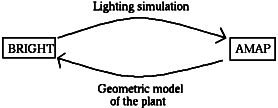






|

|

|
 |

|

|
Building realistic models of plants is not a simple task. Such models generally have the following caracteristics:
- A large number of small polygons. A single palm tree of the the image shown above, for instance, requires between several thousands of polygons.
- A structure that obeys some specific rules, that determines the particular species the plant belongs to.
- A notion of multi-scale self-similarity.
Considering these requirements, three methods seem adapted for obtaining models of plants: scanning real plants, L-systems and simulation of plant growth.
- Scanning, e.g direct data acquisition, through 3D scanners, can not be considered, because of the topological and geometrical complexity of plants. However, real plants can be used to build models of the radiometric properties measured of the leaves.
- L-systems are fractal-based plants emerging from simple sets of mathematical rules. This technique allows to build nice models of plants, but does not allow to account for the influence of natural factors on plant growth, in a biological manner.
- biological simulation of plant growth, as provided by the AMAP software is the most promising technics in terms of realism, because it allows to account in the simulation for every physiological factor like minerals and water supply, and the amount of light received by the plant.
The aim of the SOLEIL project is to simulate the action of light energy on plant development. This is be done through the collaboration of a radiative exchange simulation program, called BRIGHT, and the plant growth simulator AMAP. Up to know, AMAP is based on the asumption that the amount of light energy received by each leaf is uniform on the entire plant. The new system uses the BRIGHT software to determine the exact amount of light received by each leaf in the plant, thus considering the orientation of the leaves and macro effects like self-shadowing. AMAP incorporates this lighting information to determine the production inside each leaf, thus modifying the geometry of the model. The figure below shows the process:

Applying the radiosity method to the simulation of plant growth needs to solve some specific problems, like
- accounting for leaf partial transparency
- accounting for transparency and reflectance models for different wavelengths: infra-red, visible light, UV.
- dealing with very large geometric data bases. A single plant can be made out of thousands of polygons. The use of multi-scale representations of the geometry (clusters) greatly helps solving this problem.
This new functionnality opens the way to studying different phenomena, at various scales: